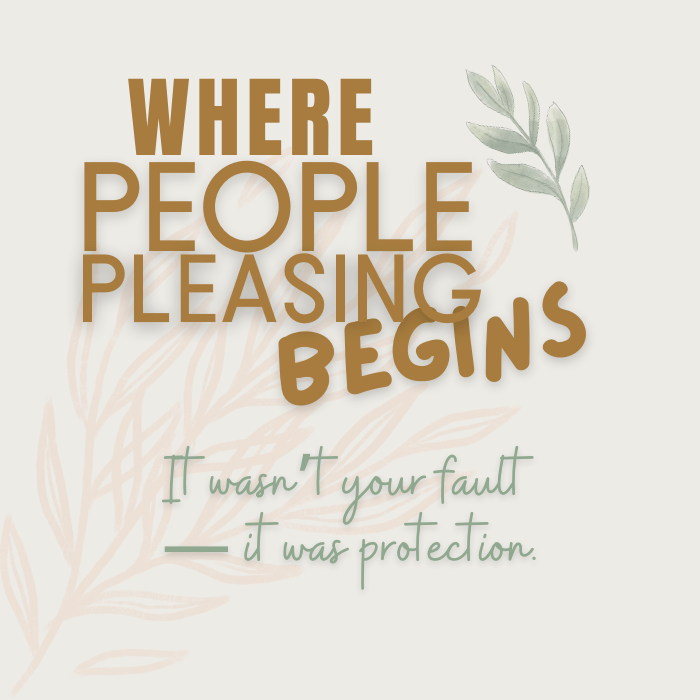(And Why It’s Not Your Fault)
If you’ve spent your life being the agreeable one — the helper, the peacekeeper, the one who smooths things over — you might assume it’s just who you are.
But most people pleasing didn’t begin as personality.
It began as protection.
Early nervous system strategies often shape these survival patterns.
Before you even had language for what was happening, your body was learning:
“This is what I need to do to stay safe, connected, and loved.”
Let’s explore some of the common roots of people pleasing — not to pathologize, but to understand.
Because when we understand where something began, we open the door to new choices.
Some links on this page are affiliate links. If you choose to purchase through them, it supports this site at no extra cost to you. Thank you for your support. 🤍
1. Safety Through Approval
For many of us, approval wasn’t just nice — it was necessary 🪷
If caregivers or early relationships responded better when we were:
- Quiet
- Helpful
- Easy to manage
- Emotionally low-maintenance
…then our bodies learned that being “good” earned connection, and anything else might lead to disconnection, punishment, or chaos.
This is where people pleasing often begins — as an unconscious trade:
“I’ll be who you want me to be, if it means I get to stay closer.”
2. Avoiding Conflict as a Survival Skill
If you grew up in an environment where anger, yelling, or tension felt overwhelming, your nervous system may have learned to preempt conflict by being overly agreeable.
This is often called the fawn response —
where instead of fighting, fleeing, or freezing, the body leans into appeasing.
You can explore more about this in the guide on Fawning + People Pleasing — how it’s not weakness, but a deep wiring of safety.
3. Emotional Neglect or Unpredictable Caregivers
Sometimes people pleasing begins not in response to direct harm — but in the quiet absence of emotional attunement.
When caregivers were distracted, inconsistent, or emotionally unavailable, children often became hyper-aware of others’ needs in an attempt to gain closeness.
They learned to read the room, soothe, adjust, please.
Not because they were manipulative — but because they were longing to feel connected.
4. Being Parentified or the “Responsible One”
If you were the child who took care of others — emotionally or physically —
your people pleasing may be an extension of that role.
It’s common for those who were parentified, or given too much emotional responsibility too early, to grow up equating love with caretaking.
Even now, you might find it hard to stop:
- Fixing
- Soothing
- Anticipating others’ needs
…even when you’re exhausted.
5. Cultural or Collective Conditioning
Beyond the family system, people pleasing can also be culturally reinforced — especially in communities where:
- Compliance is rewarded
- Assertiveness is labeled selfish
- Kindness is equated with self-erasure
Some of us learned to please not just to survive a household — but to belong in a larger system.
To not rock the boat.
To not be “too much.”
6. Sensitive Systems & Emotional Tracking
For those with sensitive or empathetic nervous systems, people pleasing can be especially automatic.
You might feel others’ tension so acutely that you adjust yourself before they even speak.
This isn’t a flaw — it’s a sensitivity that went unprotected.
Over time, your system learned:
“If others are okay, I’ll be okay too.”
You might find this guide helpful if this resonates: Sensitive Souls & Nervous System Overload.
Gentle Resources for a Deepening
The Vagus Card Deck by Melissa Romano
A beautifully designed deck that invites gentle self-inquiry and emotional reflection. Especially helpful for reconnecting with your own needs after years of tuning out your truth to keep the peace.
The Self-Therapy Workbook by Bonnie J. Weiss
A compassionate guide rooted in Internal Family Systems (IFS), this workbook helps you meet the parts of you that learned to please, appease, or stay silent — with kindness, curiosity, and new choice.
Gentle Reframe: It Was Smart
All of these patterns —
They were intelligent adaptations to your environment.
And even now, if you still notice yourself pleasing, appeasing, adjusting…
It means your body is still trying to protect you in the way it knows best.
We start to shift these patterns not by judging them —
but by meeting them with understanding and care.
If you’re curious to understand more about the deep nervous system roots of patterns like fawning and people pleasing, this article by therapist and author Jessica MaGuire offers a grounded, compassionate explanation of how early attachment wounds shape our adult responses. You can read it here: Jessica MaGuire – The Fawn Response and the Loss of Self
🌿 FAQ: The Roots of People Pleasing
Q: Does this mean I have trauma?
A: Not necessarily in the traditional sense — but many people pleasing patterns are shaped by relational nervous system stress. That includes subtle, ongoing experiences of emotional misattunement or unpredictability.
Q: Can I unlearn this if I’ve done it for decades?
A: Yes. The nervous system is plastic — it can learn new patterns, especially when given slowness, safety, and repetition.
Q: How do I know if it’s fawning vs. just being kind?
A: Kindness feels open and chosen. Fawning often feels tight, automatic, and comes with a sense of self-erasure or anxiety.
Gentle Next Step
You didn’t choose people pleasing on purpose.
You adapted — intelligently and wisely.
And now, you can begin choosing new ways of being:
Ways that include your truth, your needs, your whole self.
You don’t have to rush this.
~You don’t have to do it perfectly.
If you’re ready to explore some first soft steps, you might continue here:
→ Moving Beyond People Pleasing: First Gentle Steps
~You are unfolding. 🤍
Your unfolding is already underway — and it’s beautiful.

